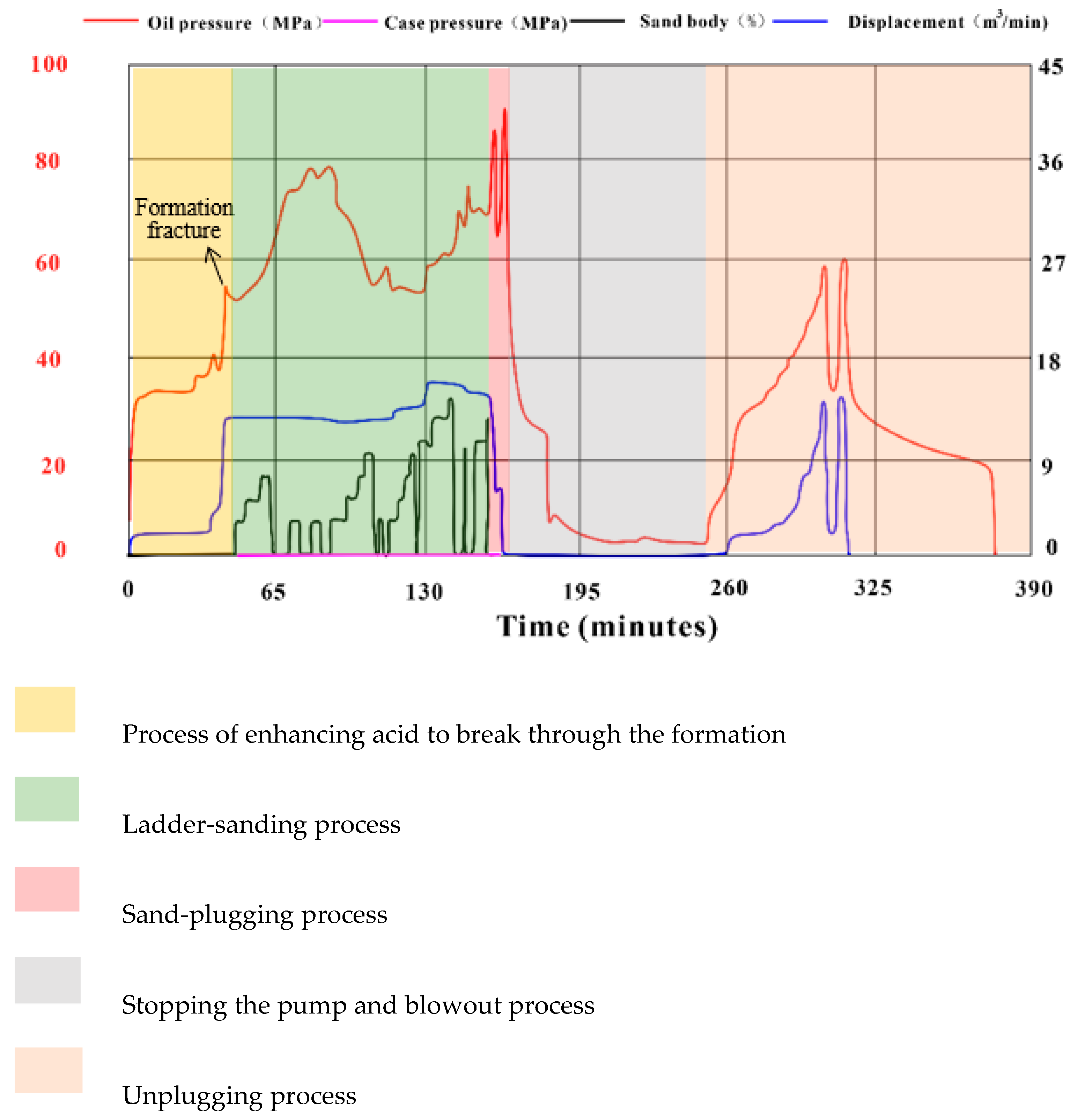New Method for Monitoring and Early Warning of Fracturing Construction
Abstract
:1. Introduction
2. Fracturing Construction Curve and Characteristic Analysis
2.1. Rising Type
2.2. Stable Type
2.3. Descending Type
2.4. Propose a New Fracturing Construction Monitoring Method
- Oil pressure–time slope
- is the oil pressure–time slope;
- is the current oil pressure, MPa;
- is the oil pressure in the last second, MPa;
- is the current time, s;
- is the last second, s.
- 2.
- Oil pressure–time slope change rate
- is the oil pressure–time slope change rate;
- is the oil pressure–time slope.
- 3.
- Oil pressure increase
- Maximum oil pressure within 5 s, MPa;
- Minimum oil pressure within 5 s, MPa;
- is the oil pressure increase within 5 s, MPa.
- 4.
- Fitted oil pressure intercept
- 5.
- Sand-blocking early-warning index
3. Application Effect Analysis
3.1. Actual Fracturing Situation of Well A1 in Fuling
- (1)
- Acid replacement stage
- (2)
- Sand-plugging stage
- (3)
- Blockage relief stage
3.2. Application of New Methods
4. Conclusions
Author Contributions
Funding
Data Availability Statement
Conflicts of Interest
References
- Ishida, T. Acoustic emission monitoring of hydraulic fracturing in laboratory and field. Constr. Build. Mater. 2001, 15, 283–295. [Google Scholar] [CrossRef]
- Liang, H.; Xian, A.; Mao, M.; Ni, P.; Wu, H. A research on remote fracturing monitoring and decision-making method supporting smart city. Sustain. Cities Soc. 2020, 62, 102414. [Google Scholar] [CrossRef]
- Liang, H.; Zou, J.; Khan, M.J.; Jinxuan, H. An sand plug of fracturing intelligent early warning model embedded in remote monitoring system. IEEE Access 2019, 7, 47944–47954. [Google Scholar] [CrossRef]
- Lu, C.; Ma, L.; Li, Z.; Huang, F.; Huang, C.; Yuan, H.; Guo, J. A novel hydraulic fracturing method based on the coupled CFD-DEM numerical simulation study. Appl. Sci. 2020, 10, 3027. [Google Scholar] [CrossRef]
- Zhang, X.; Zhang, L.; Hu, J. Real-time diagnosis and alarm of down-hole incidents in the shale-gas well fracturing process. Process Saf. Environ. Prot. 2018, 116, 243–253. [Google Scholar] [CrossRef]
- Montori, F.; Bedogni, L.; Bononi, L. A collaborative internet of things architecture for smart cities and environmental monitoring. IEEE Internet Things J. 2017, 5, 592–605. [Google Scholar] [CrossRef]
- Ahmed, E.; Yaqoob, I.; Gani, A.; Imran, M.; Guizani, M. Internet-of-things-based smart environments: State of the art, taxonomy, and open research challenges. IEEE Wirel. Commun. 2016, 23, 10–16. [Google Scholar] [CrossRef]
- Gholami, R.; Moradzadeh, A.; Maleki, S.; Amiri, S.; Hanachi, J. Applications of artificial intelligence methods in prediction of permeability in hydrocarbon reservoirs. J. Pet. Sci. Eng. 2014, 122, 643–656. [Google Scholar] [CrossRef]
- Liang, H.; Zou, J.; Zuo, K.; Khan, M.J. An improved genetic algorithm optimization fuzzy controller applied to the wellhead back pressure control system. Mech. Syst. Signal Process. 2020, 142, 106708. [Google Scholar] [CrossRef]
- Liang, H.; Liu, G.; Gao, J.; Khan, M.J. Overflow remote warning using improved fuzzy c-means clustering in IoT monitoring system based on multi-access edge computing. Neural Comput. Appl. 2020, 32, 15399–15410. [Google Scholar] [CrossRef]
- Hu, J.; Zhang, S.; Zeng, R.; Liu, Z. Early warning method for sand plugging accidents in shale gas fracturing based on deep learning. China Saf. Sci. J. 2020, 3, 108–114. [Google Scholar]
- Yu, D.; Liang, H.; Yu, X.; Luo, J.; Che, H.; Liu, G. Real-time warning system for hydraulic fracturing in Huabei Oilfield. Oil Drill. Technol. 2015, 37, 85–87. [Google Scholar]
- Tan, C.; Zhai, Q.; Wu, Y. Application of remote command and decision-making system for fracturing and acidizing construction. China Pet. Chem. Ind. Eng. 2013, 2, 53–55. [Google Scholar]
- Dong, S.; Yuan, S.; Zhang, L.; Hu, J.; Chen, Y. Research on the development strategy of safety and integrity management technology of long-distance oil and gas pipelines. Bull. Pet. Sci. 2022, 7, 435–446. [Google Scholar]
- Haiyang, D. Research and Application of Real-Time Monitoring and Early Warning System for Fracturing Sand Plugging; Southwest Petroleum University: Chengdu, China, 2017. [Google Scholar]
- Xin, Z. Research on Real-Time Risk Assessment Methods for Shale Gas Fracturing Operations and Key Equipment Based on Bayesian Network; China University of Petroleum: Beijing, China, 2019. [Google Scholar]
- Ning, I.L.C.; Nemeth, T.; Zhang, Z.; Tan, Y.; Bevc, D.; Bartel, D.; Hughes, K.; Stefani, J.; DiSiena, J. Image-based fracture hit warning system with distributed acoustic sensing. In Proceedings of the First International Meeting for Applied Geoscience & Energy, Denver, CO, USA, 26 September–1 October 2021; Society of Exploration Geophysicists: Houston, TX, USA, 2021; pp. 397–401. [Google Scholar]










Disclaimer/Publisher’s Note: The statements, opinions and data contained in all publications are solely those of the individual author(s) and contributor(s) and not of MDPI and/or the editor(s). MDPI and/or the editor(s) disclaim responsibility for any injury to people or property resulting from any ideas, methods, instructions or products referred to in the content. |
© 2024 by the authors. Licensee MDPI, Basel, Switzerland. This article is an open access article distributed under the terms and conditions of the Creative Commons Attribution (CC BY) license (https://creativecommons.org/licenses/by/4.0/).
Share and Cite
Hu, J.; Fu, M.; Yu, Y.; Li, M. New Method for Monitoring and Early Warning of Fracturing Construction. Processes 2024, 12, 765. https://doi.org/10.3390/pr12040765
Hu J, Fu M, Yu Y, Li M. New Method for Monitoring and Early Warning of Fracturing Construction. Processes. 2024; 12(4):765. https://doi.org/10.3390/pr12040765
Chicago/Turabian StyleHu, Jiani, Meilong Fu, Yang Yu, and Minxuan Li. 2024. "New Method for Monitoring and Early Warning of Fracturing Construction" Processes 12, no. 4: 765. https://doi.org/10.3390/pr12040765




